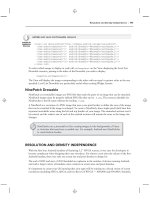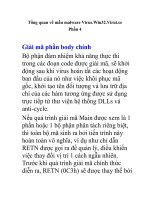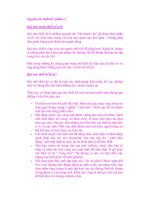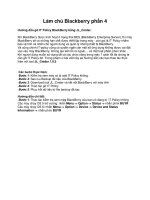Building Oracle XML Applications phần 4 ppsx
Bạn đang xem bản rút gọn của tài liệu. Xem và tải ngay bản đầy đủ của tài liệu tại đây (618.5 KB, 89 trang )
<LINE>I told him of your stealth unto this wood.</LINE>
If we turn our new utility loose on our YahooQuotesinXML.xml file to find all attributes in the file:
java XPathGrep YahooQuotesinXML.xml //@*
XPathGrep will produce:
time="Sun Apr 16 2:42am ET - U.S. Markets Closed."
Ticker="ORCL"
Price="86.188"
Ticker="GE"
Price="50.500"
Ticker="MSFT"
Price="74.688"
Ticker="IBM"
Price="118.188"
Ticker="T"
Price="34.125"
Ticker="LU"
Price="59.812"
Ticker="CSCO"
Price="67.938"
Besides being simple to implement, you'll find XPathGrep a handy sidekick in your daily work with
XML.
6.3.2 Using XPath for Reading Configuration Files
With the latest releases of the specifications for Java servlets and Enterprise Java Beans, Sun has
moved to an all-XML format for its configuration information. Here we show how simple it is to do
the same for our own programs using XPath.
Let's say we have the following Connections.xml file, which stores named database connections
and the appropriate connection information for each:
<! Connections.xml >
<connections>
<connection name="default">
<username>xmlbook</username>
<password>xmlbook</password>
<dburl>jdbc:oracle:thin:@localhost:1521:ORCL</dburl>
</connection>
<connection name="demo">
<username>scott</username>
<password>tiger</password>
<dburl>jdbc:oracle:thin:@xml.us.oracle.com:1521:xml</dburl>
</connection>
<connection name="test">
<username>test</username>
<password>test</password>
<dburl>jdbc:oracle:thin:@linuxbox:1721:ORCL</dburl>
</connection>
</connections>
We can create a ConnectionFactory class that reads the Connections.xml file as a resource from
the CLASSPATH, and returns a JDBC connection for the connection name passed in. Example 6.24
shows the implementation, which leverages the following methods:
selectSingleNode( )
To find the named connection in the XML-based configuration file
valueOf( )
On the <connection> element we find, to quickly grab the values of the interesting child
elements containing the JDBC connection information
Example 6.24. Using an XML File for Configuration
Information
import java.sql.*;
import oracle.jdbc.driver.*;
import oracle.xml.parser.v2.*;
import java.io.*;
public class ConnectionFactory {
private static XMLDocument root;
public static Connection getConnection(String name) throws Exception {
if (root == null) {
// Read Connections.xml from the runtime CLASSPATH
Class c = ConnectionFactory.class;
InputStream file = c.getResourceAsStream("Connections.xml");
if (file == null) {
throw new FileNotFoundException("Connections.xml not in CLASSPATH");
}
// Parse Connections.xml and cache the XMLDocument of config info
root = XMLHelper.parse(file,null);
}
// Prepare an XPath expression to find the connection named 'name'
String pattern = "/connections/connection[@name='"+name+"']";
// Find the first connection matching the expression above
XMLNode connNode = (XMLNode) root.selectSingleNode(pattern);
if (connNode != null) {
String username = connNode.valueOf("username");
String password = connNode.valueOf("password");
String dburl = connNode.valueOf("dburl");
String driverClass = "oracle.jdbc.driver.OracleDriver";
Driver d = (Driver)Class.forName(driverClass).newInstance( );
System.out.println("Connecting as " + username + " at " + dburl);
return DriverManager.getConnection(dburl,username,password);
}
else return null;
}
}
Then, in any program where you want to make use of this named database connection facility,
just include the lines:
import java.sql.Connection;
import ConnectionFactory;
:
Connection myConn = ConnectionFactory.getConnection("default");
With this, you'll be on your way. It's easy to edit the Connections.xml file at any time to make
changes or add new named connections, and the code in ConnectionFactory doesn't need to
change to accommodate it.
6.3.3 Using XPath Expressions as Validation Rules
In Chapter 5, we learned how the XPath expression language can be used to create a set of
flexible validation rules for XML documents. By simply attempting to select the current node with
any XPath expression applied to it as a predicate:
myNode.selectSingleNode("./self::node( )[AnyXPathExpr]")
we can determine whether the predicate is true or false. If we successfully select the current node,
then the predicate is true. If not, the predicate is false.
In Chapter 5
, we built a system to load a XPath <ruleset> document like the following into the
database.
<ruleset name="AbstractSubmission">
<rule name="Submission must have an abstract">
/Submission/Abstract
</rule>
<rule name="Author must supply First name, Last name, and Email">
/Submission/Author[Name/First and Name/Last and Email]
</rule>
<rule name="Title must be longer than 12 characters">
string-length(/Submission/Title) > 12
</rule>
<rule name="You must have previous presentation experience.">
//Author/PreviousExperience = "Yes"
</rule>
</ruleset>
However, we hinted there that it would be very useful to supply a command-line utility that
allowed developers creating ruleset files to test their sets of rules against example XML
documents outside the production database environment. Let's build that utility here.
The basic algorithm for validating a source XML document against a ruleset of XPath-based
validation rules is as follows. For each <rule> in the <ruleset>:
1. Evaluate the current rule's XPath expression as a predicate applied to the root node of the
XML document.
2. If the current rule's XPath expression tests false, then print out the current rule's name to
indicate that the rule failed.
The code in Example 6.25
is all we need to accomplish the job.
Example 6.25. Command-line Tool Validates XML Against
XPath Rulesets
import java.net.URL;
import oracle.xml.parser.v2.*;
import org.w3c.dom.*;
public class XPathValidator {
public static void main(String[] args) throws Exception {
if (args.length == 2) {
XPathValidator xpv = new XPathValidator( );
xpv.validate(args[0],args[1]);
}
else errorExit("usage: XPathValidator xmlfile rulesfile");
}
// Validate an XML document against a set of XPath validation rules
public void validate(String filename, String rulesfile) throws Exception {
// Parse the file to be validated and the rules file
XMLDocument source = XMLHelper.parse(URLUtils.newURL(filename));
XMLDocument rules = XMLHelper.parse(URLUtils.newURL(rulesfile));
// Get the name of the Ruleset file with valueOf
String ruleset = rules.valueOf("/ruleset/@name");
if (ruleset.equals("")) errorExit("Not a valid ruleset file.");
System.out.println("Validating "+filename+" against " +ruleset+" rules ");
// Select all the <rule>s in the ruleset to evaluate
NodeList ruleList = rules.selectNodes("/ruleset/rule");
int rulesFound = ruleList.getLength( );
if (rulesFound < 1) errorExit("No rules found in "+rulesfile);
else {
int errorCount = 0;
for (int z = 0; z < rulesFound; z++) {
XMLNode curRule = (XMLNode)ruleList.item(z);
String curXPath = curRule.valueOf(".").trim( );
// If XPath Predicate test fails, print out rule name as an err message
if ( !test(source,curXPath) ) {
String curRuleName = curRule.valueOf("@name");
System.out.println("("+(++errorCount)+") "+curRuleName);
}
}
if (errorCount == 0) System.out.println("No validation errors.");
}
}
// Test whether an XPath predicate is true with respect to a current node
public boolean test(XMLNode n, String xpath) {
NodeList matches = null;
try { return n.selectSingleNode("./self::node( )["+xpath+"]") != null; }
catch (XSLException xex) { /* Ignore */ }
return false;
}
private static void errorExit(String m){System.err.println(m);System.exit(1);}
}
So we can validate an XML document like our conference abstract submission:
<! Abstract_With_Error.xml >
<Submission>
<Title>Using XPath</Title>
<Author>
<Name>
<First>Steve</First>
</Name>
<Email></Email>
<Company>Oracle</Company>
<PreviousExperience>No</PreviousExperience>
</Author>
</Submission>
using the command-line utility:
java XPathValidator Abstract_With_Error.xml AbstractSubmissionRules.xml
and immediately see the validation errors:
Validating Abstract_With_Error.xml against AbstractSubmission rules
(1) Submission must have an abstract
(2) Author must supply First name, Last name, and Email
(3) Title must be longer than 12 characters
(4) You must have previous presentation experience.
even before loading the <ruleset> into the database. This tool is sure to come in handy for more
general kinds of XML document sanity checking as well. Just build a ruleset file describing the
XPath assertions you'd like to validate, and use this generic command-line tool to report any
errors.
6.4 Working with XML Messages
In this section, we'll learn the basic Java techniques required to exchange XML data:
• Over the Web in real time, by posting an XML message over HTTP to another server and
immediately receiving an XML-based response
• Asynchronously between processes, by enqueuing XML messages into and dequeuing
them out of Oracle AQ queues
These two important tasks are fundamental to the implementation of web services, the
business-to-business interchange of information using XML message formats and the HTTP
protocol.
6.4.1 Sending and Receiving XML Between Servers
As we saw in Chapter 1, the general approach for moving information of any kind around the Web
involves the exchange via requests and responses of text or binary resources over the HTTP
protocol. A requester requests information by using its Uniform Resource Locator (URL) and a
server handling requests for that URL responds appropriately, delivering the requested
information or returning an error. HTTP's request/response paradigm supports including a
resource with the request as well as receiving a resource back in the response, so it's a two-way
street for information exchange.
Any resources being exchanged between requester and server are earmarked by a distinguishing
MIME type so the receiver can understand what kind of information it is getting. The registered
MIME type for XML-based information resources is text/xml. Putting it all together, the phrase
"posting XML to another server" means precisely this: sending an HTTP POST request to that
server containing an XML document in the request body with a MIME Content-Type of text/xml.
Posting an XML datagram in the request is useful when you need to submit richly structured
information to the server for it to provide its service correctly. At other times, simple parameters
in the request are enough to get the answer you need. Here are two examples that make the
difference clear.
Each year, more and more Americans are filing their income taxes electronically over the Web. An
income tax return comprises a number of forms and schedules, each full of structured data that
the Internal Revenue Service wants to collect from you. Imagine a simplified tax return in XML as
shown in Example 6.26
.
Example 6.26. Simplified XML Tax Form
<Form id="1040" xmlns="">
<Filer EFileECN="99454">
<Name>Steven Muench</Name>
<TaxpayerId>123-45-6789</TaxpayerId>
<Occupation>XML Evangelist</Occupation>
</Filer>
<! etc. >
<Form id="8283">
<Donation Amount="300" Property="yes">
<ItemDonated>Working Refrigerator</ItemDonated>
<Donee>Salvation Army</Donee>
</Donation>
</Form>
<Schedule id="B">
<Dividend Amount="-58.74">
<Payer>Bank of America</Payer>
</Dividend>
<Dividend Amount="1234.56">
<Payer>E*Trade Securities</Payer>
</Dividend>
</Schedule>
</Form>
Before filing your return electronically, you might first want to take advantage of a tax advice web
service: you submit your tax return—over secure HTTP (https:) of course—and the service
instantly returns information about errors in your return and suggestions on how to reduce your
tax liability. To submit your tax return to the tax advice service, you need to post a structured
XML datagram to the URL of the tax advice service:
so the service can do its job analyzing all the information in your return. In response to posting
the XML tax form above, the tax advice service might reply in kind with an XML datagram back to
you that looks like this:
<TaxAdvice for="Steven Muench">
<Reminder Form="8283">
Make sure you include a documented receipt for
your "Working Refrigerator" charitable property donation!
</Reminder>
<Error Schedule="B" Line="1">
Negative dividends are not permitted. Check dividend amount of -58.74!
</Error>
</TaxAdvice>
Once you've successfully filed your return electronically with the IRS, you may be interested in
getting an updated filing status for your return. In this case, sending your entire tax return as an
XML datagram is not required. You need only provide your Social Security number as a parameter
on the URL request, like this:
and the service might respond with an XML datagram like this:
<Form DCN="12-34567-123-33" id="1040" xmlns="">
<Filer EFileECN="99454">
<Name>Steven Muench</Name>
<TaxpayerId>123-45-6789</TaxpayerId>
<Occupation>XML Evangelist</Occupation>
</Filer>
<StatusHistory>
<Status time="17 Apr 2000 23:59:59">
Your tax return was received successfully.
</Status>
<Status time="18 Apr 2000 08:11:20">
Your tax return was accepted. Your DCN is 12-34567-123-33
</Status>
</StatusHistory>
</Form>
indicating that your return has been assigned a Document Control Number. The
"send-my-whole-tax-return-in-XML" scenario is an example of doing an HTTP POST
request—when a structured XML datagram must accompany the request. The
"check-the-status-of-my-return" scenario—where only URL parameters are needed—is an
example of an HTTP GET request. In both cases, you get a structured XML response back from the
server .
To simplify these XML POSTs and XML GETs over the Web, let's implement an XMLHttp helper
class to handle the details. The class needs methods like these:
// POST an XML document to a Service's URL, returning XML document response
XMLDocument doPost(XMLDocument xmlToPost, URL target)
// GET an XML document response from a Service's URL request
XMLDocument doGet(URL target)
The doPost method needs to:
1. Open an HttpUrlConnection to the target URL
2. Indicate a request method of POST
3. Set the MIME type of the request body to text/xml
4. Indicate that we want to both write and read from the connection
5. Write the content of the XML datagram to be posted into the connection
6. Get an InputStream from the connection to read the server's response
7. Use XMLHelper.parse to parse and return the response as an XMLDocument
The doGet method is extremely simple. It only needs to use XMLHelper.parse(url) to parse and
return the response from the URL request as an XMLDocument.
Example 6.27
provides a straightforward implementation of these two useful facilities.
Example 6.27. XMLHttp Class Simplifies Posting and Getting
XML
import java.net.*;
import oracle.xml.parser.v2.*;
import java.io.*;
import org.xml.sax.*;
import java.util.Properties;
public class XMLHttp {
// POST an XML document to a Service's URL, returning XML document response
public static XMLDocument doPost(XMLDocument xmlToPost, URL target)
throws IOException, ProtocolException {
// (1) Open an HTTP connection to the target URL
HttpURLConnection conn = (HttpURLConnection)target.openConnection( );
if (conn == null) return null;
// (2) Use HTTP POST
conn.setRequestMethod("POST");
// (3) Indicate that the content type is XML with appropriate MIME type
conn.setRequestProperty("Content-type","text/xml");
// (4) We'll be writing and reading from the connection
conn.setDoOutput(true);
conn.setDoInput(true);
conn.connect( );
// (5) Print the message XML document into the connection's output stream
xmlToPost.print(new PrintWriter(conn.getOutputStream( )));
// (6) Get an InputStream to read the response from the server.
InputStream responseStream = conn.getInputStream( );
try {
// (7) Parse and return the XML document in the server's response
// Use the 'target' URL as the base URL for the parsing
return XMLHelper.parse(responseStream,target);
}
catch (Exception e) { return null; }
}
// GET an XML document response from a Service's URL request
public static XMLDocument doGet(URL target) throws IOException {
try { return XMLHelper.parse(target); }
catch (SAXException spx) { return null; }
}
// Set HTTP proxy server for current Java VM session
public static void setProxy(String serverName, String port) {
System.setProperty("proxySet","true");
System.setProperty("proxyHost",serverName);
System.setProperty("proxyPort",port);
}
}
We can test out XMLHttp to post a new <moreovernews> XML newsgram to a web service that
accepts news stories from roving web correspondents with a little program like TestXmlHttp in
Example 6.28
.
Example 6.28. Utility to Test Posting XML Newsgrams to a
Web Server
import XMLHttp;
import oracle.xml.parser.v2.XMLDocument;
import java.net.URL;
public class TestXmlHttp {
// Test posting a new News Story to our Web Site that accepts stories in XML
public static void main(String args[]) throws Exception {
// Make sure we can see through the firewall
XMLHttp.setProxy("yourproxyserver.you.com","80");
// Here's the XML 'datagram' to post a new news story in a String
String xmlDoc =
"<moreovernews>"+
" <article>"+
" <url> </url>"+
" <headline_text> Posting from Java </headline_text>"+
" <source> you </source>"+
" </article>"+
"</moreovernews>";
// Parse XML message in a string, no external references so null BaseURL OK
XMLDocument docToPost = XMLHelper.parse(xmlDoc,null);
// Here's the URL of the service that accepts posted XML news stories
String url = "
// Construct the target service URL from the string above
URL target = new URL(url);
// Post the XML message.
XMLDocument response = XMLHttp.doPost(docToPost,target);
// Print the response.
response.print(System.out);
}
}
This parses the newsgram from a String, posts it to the appropriate service URL, and prints out
the XML response from the server indicating that one story was received and accepted:
<?xml version = '1.0'?>
<xsql-status action="xsql:insert-request" rows="1"/>
Let's generalize Example 6.28
by building a useful utility called PostXML that allows us to post any
XML file to any web service from the command line. Example 6.29
shows the PostXML utility that
processes command-line arguments, then calls XMLHelper.parse and XMLHttp.doPost.
Example 6.29. PostXML Posts XML to Any URL from the
Command Line
import oracle.xml.parser.v2.*;
import java.net.*;
import org.xml.sax.*;
import XMLHttp;
public class PostXML {
public static void main(String[] args) throws Exception {
String filename = null,targetURL = null, proxy = null;
for (int z=0;z < args.length; z++) {
if (args[z].equals("-x")) {
if (args.length > z + 1) proxy = args[++z];
else errorExit("No proxy specified after -x option");
}
else if (filename == null) filename = args[z];
else if (targetURL == null) targetURL = args[z];
}
if (filename != null && targetURL != null) {
// If user supplied a proxy, set it
if (proxy != null) XMLHttp.setProxy(proxy,"80");
// Post the xml!
PostXML px = new PostXML( );
px.post(filename,targetURL);
}
else errorExit("usage: PostXML [-x proxy] xmlfile targetURL");
}
// Post XML document in 'filename' to 'targetURL'
public void post(String filename, String targetURL) {
try {
// Parse the file to be posted to make sure it's well-formed
XMLDocument message = XMLHelper.parse(URLUtils.newURL(filename));
// Construct the URL to make sure it's a valid URL
URL target = new URL(targetURL);
// Post the XML document to the target URL using XMLHttp.doPost
XMLDocument response = XMLHttp.doPost(message,target);
if (response == null) errorExit("Null response from service.");
// If successful, print out the XMLDocument response to standard out
else response.print(System.out);
}
// If the XML to post is ill-formed use XMLHelper to print err
catch (SAXParseException spx) {errorExit(XMLHelper.formatParseError(spx));}
// Otherwise, print out appropriate error messages
catch (SAXException sx) { errorExit("Error parsing "+filename); }
catch (MalformedURLException m){ errorExit("Error: "+targetURL+" invalid");}
catch (Exception ex) { errorExit("Error: "+ex.getMessage( )); }
}
private static void errorExit(String m){System.err.println(m);System.exit(1);}
}
We can now accomplish what the previous sample code did in a generic way from the command
line by using PostXML to post the XML newsgram from a file:
java PostXML -x yourproxyserver.you.com NewsStory.xml http://server/service
But we can use the PostXML utility for lots of other purposes. It will come in handy to test out any
server-side code written to handle incoming, posted XML documents. In fact, let's look next at
exactly what the server-side Java code looks like on the receiving end of a posted XML datagram.
Since these messages are posted over HTTP, and since Java servlets are designed to enable you
to easily write server-side programs that handle HTTP requests, it's natural to study a servlet
example.
While the service it provides is arguably of little value, the XMLUpperCaseStringServlet in
Example 6.30
serves as a complete example for:
1. Receiving an XML datagram in the HTTP POST request and parsing it
2. Processing the data by using XPath expressions and selectNodes
3. Changing the document in some interesting way
4. Writing back an XML document as a response
The service we're providing in Example 6.30
is to accept any posted XML document, search it for
<String> elements, uppercase the value of each of these <String> elements, and write the
modified document back as the response XML datagram.
In Chapter 8
, Chapter 9, and Chapter 11, we'll see how to make these services much more
interesting by interacting with your database information.
Example 6.30. Receiving, Parsing, Searching, and
Manipulating Posted XML
import javax.servlet.http.*;
import oracle.xml.parser.v2.*;
import org.w3c.dom.*;
import org.xml.sax.SAXException;
import java.net.URL;
import javax.servlet.ServletException;
import java.io.*;
public class XMLUpperCaseStringServlet extends HttpServlet {
// Handle the HTTP POST request
protected void doPost(HttpServletRequest req, HttpServletResponse resp)
throws ServletException, IOException {
XMLDocument incomingXMLDoc = null;
// Tell the requester she's getting XML in response
resp.setContentType("text/xml");
// Get the character writer to write the response into
PrintWriter out = resp.getWriter( );
try {
// If we're receiving posted XML
if (req.getContentType( ).equals("text/xml")) {
// Get the InputStream on the HTTP POST request's request body
InputStream incomingXMLStream = req.getInputStream( );
// Parse it with our helper
incomingXMLDoc = XMLHelper.parse(incomingXMLStream,null);
// Find any <String> elements in the posted doc using selectNodes
NodeList stringElts = incomingXMLDoc.selectNodes("//String");
// Loop over any matching nodes and uppercase the string content
int matches = stringElts.getLength( );
for (int z=0; z<matches; z++) {
Text t = (Text)stringElts.item(z).getFirstChild( );
// Uppercase the node value of the first text-node Child
t.setNodeValue(t.getNodeValue( ).toUpperCase( ));
}
// Write posted XML doc (with <String>'s now uppercased) to response
incomingXMLDoc.print(out);
}
else out.println("<error>You did not post an XML document</error>");
}
catch (SAXException s) {
out.println("<error>You posted an ill-formed XML document</error>");
}
catch (XSLException x) {
out.println("<error>Error processing selectNodes</error>");
}
}
}
You'll notice that the only new trick is the use of the getContentType method on the
HttpServletRequest to sense if we're receiving posted XML, and the getInputStream method to
retrieve the contents of the posted document. If we use PostXML to test out our new servlet on
the following Sample.xml file:
<! Sample.xml >
<Something>
<Containing>
<String>this is a string</String>
<String>this is too</String>
</Containing>
<String>And a third </String>
</Something>
with the command line:
java PostXML Sample.xml http://localhost/servlets/XMLUpperCaseStringServlet
We get back the XML response that includes the results of the service:
<! Sample.xml >
<Something>
<Containing>
<String>THIS IS A STRING</String>
<String>THIS IS TOO</String>
</Containing>
<String>AND A THIRD </String>
</Something>
So we now we've seen how to both pitch and catch XML information over the Web.
6.4.2 Acquiring XML Data from Another Server
Next let's walk through an example of retrieving XML information from another web site from
inside Oracle8i. Just to mix things up a little, we'll show how Java and PL/SQL can be used
together to accomplish the job. We will do the following:
1. Build a class called CaptureQuotes that will:
o Use our JTidyConverter and YahooQuotes-to-QuoteStream.xsl transformation to
retrieve live XML <QuoteStream> data from Yahoo! Quotes over the Web
o Insert the Ticker and Price information returned with each <Quote> into the
database by invoking a stored procedure to do the handling
2. Create the latest_quotes table and an insert_quote stored procedure in PL/SQL that will
make sure only a single latest quote per day per ticker symbol stays in our table
3. Test our CaptureQuotes outside the database, then deploy it as a Java stored procedure
so it can be executed periodically by a DBMS_JOB database job
4. Deal with a few new JServer permissions that we'll need to make the whole thing work
So let's get started, taking the simple steps first. We can create the table to store our latest
quotes with the following command:
CREATE TABLE latest_quotes (
ticker VARCHAR2(7),
price NUMBER,
day DATE
);
And creating the PL/SQL stored procedure to handle inserting a quote is easy, too:
CREATE OR REPLACE PROCEDURE insert_quote(sym VARCHAR2,cost NUMBER,eff DATE) IS
BEGIN
Remove any previous "latest" quote from today for this symbol.
Make sure an Oracle8i Functional index on (TRUNC(day),ticker) exists!
DELETE FROM latest_quotes
WHERE ticker = sym
AND TRUNC(day) = TRUNC(eff);
INSERT INTO latest_quotes VALUES(sym,cost,eff);
END;
Note that insert_quote first deletes any existing "latest" quote for the current ticker symbol by
searching the table for a row with the current ticker symbol and a TRUNC(day) equal to the
TRUNC(eff) effective date of the current quote being handled. Since this latest_quotes table may
contain millions of rows—as we might accumulate years of historical stock quotes—we need this
DELETE statement to be fast. Normally a WHERE clause that uses a function like TRUNC( ) on a
column immediately forfeits the use of the index, but Oracle8i sports a neat new feature called
functional indexes that allows us to happily issue the CREATE INDEX statement:
CREATE INDEX latest_quotes_idx ON latest_quotes (TRUNC(day),ticker);
Your database user needs to be granted the QUERY REWRITE
privilege—or be granted a role that has been granted the
permission—in order to successfully create a functional index.
So any search on the combination of ticker symbol and TRUNC(day) will be lightning fast. Next
we'll create CaptureQuotes. The guts of this class will borrow from our earlier
YahooXMLQuotesServlet, but with a few interesting twists. First, we'll read the XSLT stylesheet
to perform the transformation using the handy xmldoc URLs we created earlier. This means that
we can store the YahooQuotes-to-QuoteStream.xsl stylesheet in our xml_documents table and
easily retrieve it for use at any time without leaving the database. Second, rather than simply
spitting back the XML <QuoteStream> as the servlet did earlier, we'll use the XPath searching
facilities to loop over all of the matching quotes and insert each one in the database. Third, we'll
use a JDBC CallableStatement to execute the insert_quote stored procedure after binding the
values of the current quote information.
Note that after retrieving the Yahoo! Quotes as an XML <QuoteStream> we could simply call
XMLDocuments.save( ) to save our <QuoteStream> XML document in a CLOB, but this is not our
intention here. We want the historical data to be usable by existing report writing tools like Oracle
Reports, and existing data warehousing tools like Oracle Discoverer. We want to use powerful
SQL queries to sort and group and summarize the data to look for trends and quickly generate
charts and graphs. So having the information in regular rows of a regular database table makes
a whole lot of sense.
Example 6.31
shows the code for CaptureQuotes.
Example 6.31. Java Stored Procedure to Retrieve and Store
Web Stock Quotes
import javax.servlet.http.*;
import oracle.xml.parser.v2.*;
import org.w3c.dom.*;
import java.net.URL;
import java.sql.*;
import java.io.*;
import JTidyConverter;
import XMLDocuments;
import Examples;
public class CaptureQuotes {
private static CaptureQuotes cq = null;
private Connection conn = null;
private JTidyConverter jtc = null;
private XSLStylesheet sheet = null;
private CallableStatement stmt = null;
private static final String YQUOTES = "
public CaptureQuotes(Connection conn) {
this.conn = conn;
}
// Oracle8i Java stored procedure debugging entry point for testing.
public static void debug_main( ) throws Exception {
storeLatestQuotesFor("ORCL,INTC,MSFT");
}
// Static method to expose as Java stored procedure
public static void storeLatestQuotesFor(String symbolList) throws Exception {
if (cq == null) {
cq = new CaptureQuotes(Examples.getConnection( ));
cq.initialize( );
}
cq.retrieve(symbolList);
}
// Retrieve Yahoo Quotes and save quote data in a table
private void retrieve(String symbolList) throws Exception {
if (symbolList != null && !symbolList.equals("")) {
URL yahooUrl = new URL(YQUOTES+symbolList.replace(',','+'));
// Convert the dynamically produced Yahoo! Quotes page to XML doc
XMLDocument yahooquotes = jtc.XMLifyHTMLFrom(yahooUrl);
// Transform the document using our stylesheet into <QuoteStream>
// getting the transformed result in a DocumentFragment
XSLProcessor xslt = new XSLProcessor( );
DocumentFragment result = xslt.processXSL(sheet,yahooquotes);
// Get the document element of the transformed document
XMLElement e = (XMLElement)result.getFirstChild( );
// Search for all <Quotes> in the resulting <QuoteStream>
NodeList quotes = e.selectNodes(".//Quote");
int matches = quotes.getLength( );
// Loop over any quotes retrieved; insert each by calling stored proc
for (int z = 0; z < matches; z++) {
XMLNode curQuote = (XMLNode)quotes.item(z);
// Bind the 1st stored procedure argument to valueOf Ticker attribute
stmt.setString(1,curQuote.valueOf("@Ticker"));
// Bind the 2ND stored procedure argument to valueOf Price attribute
stmt.setString(2,curQuote.valueOf("@Price"));
// Execute the stored procedure to process this quote
stmt.executeUpdate( );
}
conn.commit( );
}
}
// Setup proxy server, Cache XSL Transformation, and Callable Statement
private void initialize( ) throws Exception {
if (jtc == null) {
// Make sure the Servlet can "see" through the corporate firewall
System.setProperty("proxySet","true");
System.setProperty("proxyHost","yourproxyserver.you.com");
System.setProperty("proxyPort","80");
// Construct a JTidyConverter. We can use the same one over and over.
jtc = new JTidyConverter( );
XMLDocuments.enableXMLDocURLs( );
// Read the Yahoo2Xml.xsl stylesheet from an xmldoc:// URL in the DB
URL u = new URL("xmldoc:/transforms/YahooQuotes-to-QuoteStream.xsl");
InputStream styleSource = u.openStream( );
// Cache a new stylesheet. Not threadsafe in 2.0.2.7 but OK for demo.
sheet = new XSLStylesheet(styleSource,null); // No base URL needed here!
// Cache a reusable CallableStatement for invoking the PL/SQL Stored Proc
stmt = conn.prepareCall("BEGIN insert_quote(?,?,SYSDATE); END;");
}
}
}
Note that the initialize( ) routine:
• Sets Java System properties to allow the program to talk to URLs outside the firewall
• Constructs a JTidyConverter to use for the life of the session
• Reads the stylesheet from xmldoc:/transforms/YahooQuotes-to-QuoteStream.xsl and
constructs a new XSLStylesheet object to use for the life of the session
• Creates a reusable CallableStatement object to execute over and over again with
different bind variable values to invoke the stored procedure
Also note that we've added a debug_main( ) method so we can use JDeveloper's JServer
debugging feature to find any problems that crop up. To test CaptureQuotes outside the
database, we can put the following lines of code in a little tester class:
CaptureQuotes.storeLatestQuotesFor("ORCL,INTC");
CaptureQuotes.storeLatestQuotesFor("WBVN,MSFT,IBM,WEBM");
This will test to make sure we can make multiple calls to the CaptureQuotes class in the same
session with no problem. After doing this, if we execute the SQL statement:
SELECT ticker, price, TO_CHAR(day,'MM/DD/YY HH24:MI') day
FROM latest_quotes
WHERE TRUNC(day) = TRUNC(SYSDATE)
ORDER BY 3,1
we'll see the latest quote data retrieved from over the Web sitting comfortably in our local
database table:
TICKER PRICE DAY
IBM 111.875 04/17/00 17:47
INTC 123 04/17/00 17:47
MSFT 75.875 04/17/00 17:47
ORCL 74.812 04/17/00 17:47
WBVN 4.531 04/17/00 17:47
WEBM 61.75 04/17/00 17:47
Finally, we'll deploy CaptureQuotes as a Java stored procedure into JServer. We went through
the basic steps earlier in the chapter, so we'll just highlight what's unique this time.
We use JDeveloper to create a new Java stored procedure deployment profile and select the
debug_main and storeLatestQuotesFor static methods of the CaptureQuotes class to be
published. We choose a name like YAHOOQUOTES (it can be different from the class name) for the
package in which JDeveloper will publish our two selected methods as package procedures.
Before deploying your Java stored procedure, you need to load the .jar file for the JTidy bean into
the database. This is done with the one-line command:
loadjava -verbose -resolve -user xmlbook/xmlbook tidy.jar
Then you can select your Java stored procedure profile to deploy it and everything should go
smoothly. JDeveloper's deployment wizard will automatically create the necessary Java stored
procedure specification:
CREATE OR REPLACE PACKAGE YAHOOQUOTES AUTHID CURRENT_USER AS
PROCEDURE STORELATESTQUOTESFOR ("symbolList" IN VARCHAR2)
AS LANGUAGE JAVA
NAME 'CaptureQuotes.storeLatestQuotesFor(java.lang.String)';
END YAHOOQUOTES;
And after loading the XSLT stylesheet into our xml_documents table (arguments all go on one
line):
java XMLDoc save YahooQuotes-to-QuoteStream.xsl
/transforms/YahooQuotes-to-QuoteStream.xsl
we're good to go!
You can connect to the database in SQL*Plus and give the new Java stored procedure a whirl by
typing something like this to get the latest quotes for Apple Computer, Oracle, and Healtheon:
EXEC yahooquotes.storeLatestQuotesFor('AAPL,ORCL,HLTH')
At this point, it will either work correctly, or fail with a JServer security violation. The XMLBOOK
user needs the appropriate java.util.PropertyPermission to be able to set the System
variables to affect the proxy server name, as well as the familiar java.net.SocketPermission
from an earlier example for the *.yahoo.com domain. The script in Example 6.32
—run as
SYS—grants XMLBOOK the appropriate privileges.
Example 6.32. Granting Privileges to Connect to an External
Web Site
BEGIN
Grant Permission to set the proxy* System properties
dbms_java.grant_permission(
grantee => 'XMLBOOK',
permission_type => 'SYS:java.util.PropertyPermission',
permission_name => 'proxySet',
permission_action => 'write');
dbms_java.grant_permission(
grantee => 'XMLBOOK',
permission_type => 'SYS:java.util.PropertyPermission',
permission_name => 'proxyHost',
permission_action => 'write');
dbms_java.grant_permission(
grantee => 'XMLBOOK',
permission_type => 'SYS:java.util.PropertyPermission',
permission_name => 'proxyPort',
permission_action => 'write');
Grant Permission to resolve and connect to URL at *.yahoo.com
dbms_java.grant_permission(
grantee => 'XMLBOOK',
permission_type => 'SYS:java.net.SocketPermission',
permission_name => '*.yahoo.com',
permission_action => 'connect,resolve');
COMMIT;
END;
Retry the stored procedure and rerun the query from before:
TICKER PRICE DAY
IBM 111.875 04/17/00 17:47
INTC 123 04/17/00 17:47
MSFT 75.875 04/17/00 17:47
WBVN 4.531 04/17/00 17:47
WEBM 61.75 04/17/00 17:47
AAPL 123.875 04/17/00 18:27
HLTH 19.375 04/17/00 18:27
ORCL 74.812 04/17/00 18:27
to see that the new quotes for AAPL and HLTH have been added and the latest quote for ORCL for
today has been properly revised by the insert_quote procedure. We'll leave it as an exercise to
investigate setting up a periodic execution of yahooquotes.storeLatestQuotesFor in a
database cron job. The steps are the same as in the "Move bad XML documents to another table
in batch" exercise in Chapter 5
that used the DBMS_JOB.SUBMIT procedure.
6.4.3 Handling Asynchronous XML Messages in Queues
The examples in the previous few sections dealt with posting and getting XML in real time over the
Web. This meant making a request and waiting for the response. Sometimes the requester may
be interested in getting the process started, but may not be prepared to sit around waiting for a
response. This is typically the case when delivering the ultimate response—like receiving a book
in the mail that you ordered online—involves multiple, potentially time-consuming steps. This is
a perfect scenario for exploiting Oracle8i 's Advanced Queuing (AQ) feature.
In Chapter 5
, we created an AQ queue called xml_msg_queue and used a PL/SQL helper package
called xmlq to easily enqueue and dequeue XML-based messages. Here we'll uncover the
analogous facilities in Oracle AQ's Java API and get the PL/SQL and Java programs talking XML
through the queue. An Oracle AQ can have one of two kinds of message payloads: a "Raw"
payload of up to 32K bytes, or a structured Oracle8 object type. We'll study the simplest of the
two—the Raw payload—in order to learn the ropes.
The .jar file for Oracle's AQ Java API is in ./rdbms/jlib/aqapi.jar
under your Oracle installation home. AQ also offers a Java
Messaging Service ( JMS)-compliant API. Our examples use the
AQ native Java API.
To use an AQ queue, you need to do the following:
1. Be in the context of a JDBC database connection
2. Create a session with the queuing system
3. Ask the session to give you a handle to the queue you want to work with, given the schema
and name of the queue
We handle these administrative steps in the XMLQueue constructor in Example 6.33
. So to work
with an queue like XMLBOOK's xml_msg_queue, we'll use code like this:
XMLQueue q = new XMLQueue(conn, "xmlbook","xml_msg_queue");
to get started. Since our XMLQueue class encapsulates access to an AQ queue, we need it to model
the two key operations we want to do with XML documents over a queue: enqueue an XML
message and dequeue an XML message. Appropriately, we'll add enqueue and dequeue methods
to our XMLQueue class. The steps involved in enqueuing an XML message are as follows:
1. Serialize the in-memory XML document as a byte array of XML markup.
2. Ask the queue to create a new, empty message.
3. Get a handle to the message's RawPayload "bay."
4. Write the byte array into the payload.
5. Enqueue the message.
6. Commit.
The steps required to dequeue a message are as follows:
1. Optionally set a flag to indicate whether we want to wait for a message.
2. Attempt to dequeue the message, raising an error if the queue is empty and we chose not
to wait.
3. Get a handle to the message's RawPayload "bay."
4. Create an InputStream on the byte array in the message.
5. Parse the InputStream of bytes into an XMLDocument.
6. Commit, and return the XMLDocument.
The full implementation is shown in Example 6.33
.
Example 6.33. XMLQueue Class Simplifies Enqueuing and
Dequeuing XML
import oracle.xml.parser.v2.*;
import java.sql.*;
import oracle.AQ.*;
import java.io.*;
import org.xml.sax.SAXException;
import XMLQueueEmptyException;
public class XMLQueue {
private Connection conn = null;
private AQSession sess = null;
private AQQueue queue = null;
// Constructing an XMLQueue "binds" it to a particular AQ Queue
public XMLQueue(Connection conn, String schema,String queueName)
throws AQException,SQLException {
this.conn = conn;
conn.setAutoCommit(false);
// Create the AQ Driver
AQOracleDriver driver = new AQOracleDriver( );
// Create a new session to work in
sess = AQDriverManager.createAQSession(conn);
// Get a handle to the requested queue
queue = sess.getQueue (schema,queueName);
}
// Enqueue an XMLDocument to the queue
public void enqueue( XMLDocument xmldoc ) throws AQException,IOException,
SQLException {
ByteArrayOutputStream baos = new ByteArrayOutputStream( );
// Print the XML document to serialize it as XML Markup
xmldoc.print(baos);
// Get the bytes to enqueue into the "Raw" message
byte[] messageBytes = baos.toByteArray( );
// Ask the queue to create an empty message
AQMessage message = queue.createMessage( );
// Get the Raw Payload "bay" to write the message into
AQRawPayload payload = message.getRawPayload( );
// Set the contents of the payload to be the bytes of our XML Message
payload.setStream(messageBytes,messageBytes.length);
// Send the new message on its way into the queue
queue.enqueue(new AQEnqueueOption( ),message);
// Sign, seal, and deliver
conn.commit( );
}
// Dequeue and return an XMLDocument from the queue
public XMLDocument dequeue(boolean wait) throws AQException,
SQLException,
XMLQueueEmptyException {
AQDequeueOption dqOpt = new AQDequeueOption( );
// If user asked NOT to wait, then set this flag in the Dequeue Options
if (!wait) {
dqOpt.setWaitTime(AQDequeueOption.WAIT_NONE);
}
AQMessage message = null;
try {
// Try to dequeue the message
message = queue.dequeue(dqOpt);
}
catch (oracle.AQ.AQOracleSQLException aqx) {
// If we get an error 25228 then queue was empty and we didn't want to wait
if (java.lang.Math.abs(aqx.getErrorCode( )) == 25228) {
throw new XMLQueueEmptyException( );
}
}
// Retrieve the Raw Payload "bay" from the message
AQRawPayload payload = message.getRawPayload( );
// Create an InputStream on the bytes in the message
ByteArrayInputStream bais = new ByteArrayInputStream(payload.getBytes( ));
XMLDocument dequeuedDoc = null;
try {
// Parse the XML message
dequeuedDoc = XMLHelper.parse(bais,null);
}
catch (Exception spe) { /* Ignore, doc will be null */ }
// Finalize the transactional dequeue operation by committing
conn.commit( );
// Return the XMLDocument
return dequeuedDoc;
}
}
We can write a quick command-line test program called AQ to experiment with enqueuing and
dequeuing XML orders. Here we'll exercise the XMLQueue class to enqueue and dequeue orders
that are very simple—albeit perfectly valid—XML documents like:
<order id="101"/>
but the mechanics are identical for enqueuing and dequeuing any XML message up to 32K bytes
with the Raw payload technique. The implementation is shown in Example 6.34
.
By using an Oracle AQ queue with an object type
payload—instead of the Raw payload we're experimenting with
here—and basing it on an object type with a CLOB attribute
like:
CREATE TYPE xml_message AS OBJECT(xml CLOB [,
other-attrs]);
you can easily enqueue and dequeue XML messages of
essentially any size by storing the XML message in the CLOB
attribute of the object type message.
Example 6.34. Utility to Test Enqueuing and Dequeuing
Messages
import java.sql.*;
import oracle.AQ.*;
import Examples;
import java.io.*;









